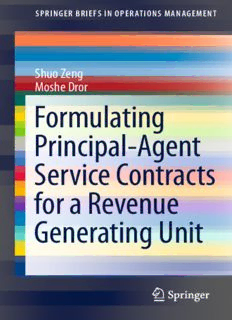Table Of ContentSPRINGER BRIEFS IN OPERATIONS MANAGEMENT
Shuo Zeng
Moshe Dror
Formulating
Principal-Agent
Service Contracts
for a Revenue
Generating Unit
SpringerBriefs in Operations Management
SeriesEditor
SureshP.Sethi
SchoolofManagement
TheUniversityofTexasatDallas
Richardson,TX,USA
Moreinformationaboutthisseriesathttp://www.springer.com/series/13082
Shuo Zeng • Moshe Dror
Formulating Principal-Agent
Service Contracts for a
Revenue Generating Unit
123
ShuoZeng MosheDror
EllerCollegeofManagement EllerCollegeofManagement
UniversityofArizona UniversityofArizona
Tucson,AZ,USA Tucson,AZ,USA
SpringerBriefsinOperationsManagement
ISBN978-3-319-18671-9 ISBN978-3-319-18672-6 (eBook)
DOI10.1007/978-3-319-18672-6
LibraryofCongressControlNumber:2015942238
SpringerChamHeidelbergNewYorkDordrechtLondon
©SpringerInternationalPublishingSwitzerland2016
Thisworkissubjecttocopyright.AllrightsarereservedbythePublisher,whetherthewholeorpartof
thematerialisconcerned,specificallytherightsoftranslation,reprinting,reuseofillustrations,recitation,
broadcasting,reproductiononmicrofilmsorinanyotherphysicalway,andtransmissionorinformation
storageandretrieval,electronicadaptation,computersoftware,orbysimilarordissimilarmethodology
nowknownorhereafterdeveloped.
Theuseofgeneraldescriptivenames,registerednames,trademarks,servicemarks,etc.inthispublication
doesnotimply,evenintheabsenceofaspecificstatement,thatsuchnamesareexemptfromtherelevant
protectivelawsandregulationsandthereforefreeforgeneraluse.
Thepublisher,theauthorsandtheeditorsaresafetoassumethattheadviceandinformationinthisbook
arebelievedtobetrueandaccurateatthedateofpublication.Neitherthepublishernortheauthorsor
theeditorsgiveawarranty,expressorimplied,withrespecttothematerialcontainedhereinorforany
errorsoromissionsthatmayhavebeenmade.
Printedonacid-freepaper
SpringerInternationalPublishingAGSwitzerlandispartofSpringerScience+BusinessMedia(www.
springer.com)
Contents
1 Introduction .................................................................. 1
2 TheBasicPrincipal-Agent.................................................. 3
2.1 ContractualRelationshipBetweenaPrincipalandanAgent......... 6
3 Risk-NeutralAgent .......................................................... 9
3.1 OptimalStrategiesforRisk-NeutralAgent............................ 11
3.1.1 SensitivityAnalysisoftheOptimalStrategy.................. 15
3.1.2 TheSecond-BestSolution...................................... 16
3.1.3 OurPrincipal-AgentGame..................................... 17
4 Risk-AverseAgent ........................................................... 19
4.1 OptimalStrategieswithaWeaklyRisk-AverseAgent................ 23
4.1.1 SensitivityAnalysisofaWeaklyRisk-Averse
Agent’sOptimalStrategy....................................... 33
4.1.2 Principal’sOptimalStrategy ................................... 36
4.2 OptimalStrategiesGivenaStronglyRisk-AverseAgent ............. 45
4.2.1 SensitivityAnalysisofaStronglyRisk-Averse
Agent’sOptimalStrategy....................................... 54
4.2.2 Principal’sOptimalStrategy ................................... 56
4.3 Risk-AverseAgent:ASummary....................................... 60
4.3.1 SensitivityAnalysisofOptimalStrategiesinHigh
RevenueIndustry ............................................... 61
4.3.2 TheSecond-BestSolutioninHighRevenueIndustry ........ 63
5 Risk-SeekingAgent.......................................................... 65
5.1 OptimalStrategiesfortheWeaklyRisk-SeekingAgent .............. 68
5.1.1 SensitivityAnalysisofaWeaklyRisk-Seeking
Agent’sOptimalStrategy....................................... 81
5.1.2 Principal’sOptimalStrategy ................................... 83
v
vi Contents
5.2 OptimalStrategiesfortheModeratelyRisk-SeekingAgent.......... 89
5.2.1 Sensitivity Analysis of a Moderately
Risk-SeekingAgent’sOptimalStrategy....................... 97
5.2.2 Principal’sOptimalStrategy ................................... 99
5.3 OptimalStrategiesfortheStronglyRisk-SeekingAgent............. 102
5.4 Risk-SeekingAgent:ASummary...................................... 104
6 Summary...................................................................... 107
6.1 InterpretingTable6.1................................................... 109
Acknowledgment................................................................. 113
Appendix.......................................................................... 115
References......................................................................... 125
Index............................................................................... 127
List of Figures
Fig.3.1 Illustrationoftheformsofu.(cid:2)/ ..................................... 12
Fig.3.2 StructureoftheproofforProposition3.3 ........................... 12
Fig.3.3 Conditionswhenarisk-neutralagentacceptsthecontract ......... 13
Fig.3.4 StructureoftheproofforTheorem3.4.............................. 14
Fig.3.5 Structureoftheprincipal-agentextensiveformgame .............. 18
Fig.4.1 (cid:3).(cid:2);w;p/asafunctionofP.1/when(cid:4)D1 ....................... 20
Fig.4.2 Illustrationoftheformsofu.(cid:2)/when(cid:4)2.0;3=5(cid:5)................. 26
Fig.4.3 StructureoftheproofforProposition4.9when(cid:4)2.0;3=5(cid:5)....... 27
Fig.4.4 Illustrationoftheformsofu.(cid:2)/when(cid:4)2.3=5;4=5/.............. 30
Fig.4.5 StructureoftheproofforProposition4.9when(cid:4)2.3=5;4=5/.... 31
Fig.4.6 Conditionswhenaweaklyrisk-averseagentaccepts
thecontractwith(cid:4)D0:6............................................. 33
Fig.4.7 StructureoftheproofforProposition4.18.......................... 40
Fig.4.8 StructureoftheproofforTheorem4.19andProposition4.20..... 44
Fig.4.9 Thevalueof…Q (cid:2)… .w(cid:2);p(cid:2) Dp I(cid:2)(cid:2)/
P P cu
(cid:3)…P.w(cid:2);p(cid:2) Dp3I(cid:2)(cid:2)/forr2.p3;r2/.............................. 46
Fig.4.10 Illustrationoftheformsofu.(cid:2)/when(cid:4)2Œ4=5;1/................. 48
Fig.4.11 StructureoftheproofforProposition4.23when(cid:4)2Œ4=5;1/..... 49
Fig.4.12 Illustrationoftheformsofu.(cid:2)/when(cid:4)(cid:4)1........................ 51
Fig.4.13 StructureoftheproofforProposition4.23when(cid:4)(cid:4)1............ 52
Fig.4.14 Conditionswhenastronglyrisk-averseagentaccepts
thecontractwith(cid:4)D2............................................... 54
Fig.4.15 StructureoftheproofforTheorem4.27............................. 58
Fig.4.16 Conditionswhenarisk-neutralprincipalmakesoffers
toarisk-averseagent ................................................. 61
Fig.5.1 (cid:3).(cid:2);w;p/asafunctionofP.1/when(cid:4)D(cid:3)1 ..................... 66
Fig.5.2 Illustrationoftheformsofu.(cid:2)/when(cid:4)2.0;3=4(cid:5)................. 73
Fig.5.3 StructureoftheproofforProposition5.10when(cid:4)2.0;3=4(cid:5) ..... 74
Fig.5.4 Illustrationoftheformsofu.(cid:2)/when(cid:4)2.3=4;8=9/.............. 76
Fig.5.5 StructureoftheproofforProposition5.10when(cid:4)2.3=4;8=9/.. 77
vii
viii ListofFigures
Fig.5.6 Conditionswhenaweaklyrisk-seekingagentaccepts
thecontractwith(cid:4)D0:5............................................. 80
Fig.5.7 StructureoftheproofforTheorem5.17............................. 87
Fig.5.8 Illustrationoftheformsofu.(cid:2)/when(cid:4)2Œ8=9;1/................. 92
Fig.5.9 StructureoftheproofforProposition5.19when(cid:4)2Œ8=9;1/ ..... 93
Fig.5.10 Illustrationoftheformsofu.(cid:2)/when(cid:4)2Œ1;2/ ................... 95
Fig.5.11 StructureoftheproofforProposition5.19when(cid:4)2Œ1;2/........ 96
Fig.5.12 Conditions when a moderately risk-seeking agent
acceptsthecontractwith(cid:4)D1...................................... 98
Fig.5.13 StructureoftheproofforTheorem5.22............................. 101
Fig.5.14 Illustrationoftheformsofu.(cid:2)/when(cid:4)(cid:4)2........................ 103
Fig.5.15 StructureoftheproofforProposition5.24when(cid:4)(cid:4)2............ 103
Fig.5.16 Conditionswhenaprincipalmakescontractofferstoa
risk-seekingagent..................................................... 105
List of Tables
Table 2.1 Thevariablesofthemodel........................................... 5
Table 4.1 Indicators of the monotonicity and the
concavity/convexityoffunctionu.(cid:2)/in(4.3) ...................... 22
Table 5.1 Indicators of the monotonicity and the
concavity/convexityoffunctionu.(cid:2)/in(5.3) ...................... 69
Table 6.1 Summary of the optimal principal-agent contract
formulasunderexogenousconditions............................... 110
ix
Description:This book examines contractual options for a performance based contract between an owner of a revenue generating unit and a repair agent for such unit. The framework of the analysis is that of economists' principal-agent problem. The contractual options of a principal and an agent are modeled as a M

